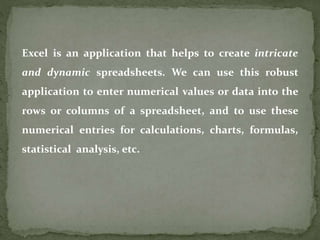Excel is an application used to create spreadsheets containing numerical values, formulas, and charts. It allows users to enter data into cells organized into rows and columns and perform calculations on that data. The basic elements of an Excel file include worksheets containing grids of cells organized by column letters and row numbers, grouped together in workbooks. Formulas and functions can be used to calculate and analyze the data in cells. Common tasks like formatting, sorting, conditional formatting, and summarizing data help users understand and visualize information in Excel spreadsheets.
































![The IF function returns one value if a condition you
specify evaluates to TRUE, and another value if that
condition evaluates to FALSE.
For example, the formula =IF(A1>10,"Over 10","10 or
less") returns "Over 10" if A1 is greater than 10, and "10
or less" if A1 is less than or equal to 10.
Syntax
IF(logical_test, value_if_true, [value_if_false])](https://image.slidesharecdn.com/i-200825125341/85/Excel-2007-for-Retail-33-320.jpg)













